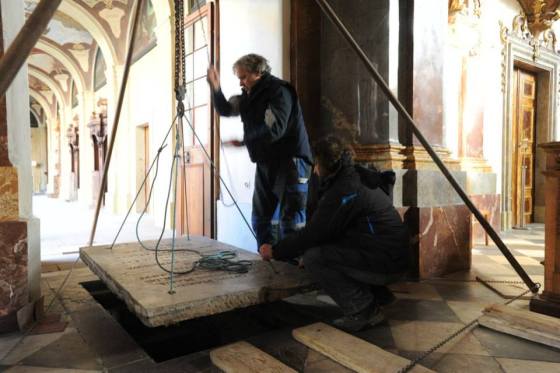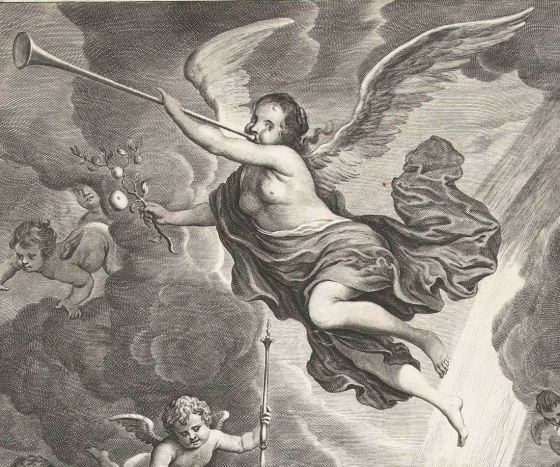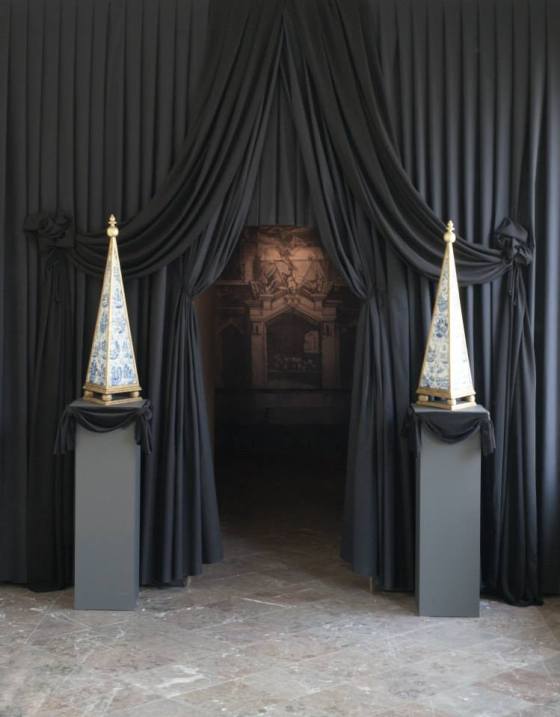Don’t you sometimes wonder what it would be like to enter a crypt that has not been accessed for hundreds of years and to discover, in Howard Carter’s words, “wonderful things”? Such an event occurred in the Church of the Nativity in the Sanctuary of Our Lady of Loreto, Prague, in 2011.
The church lies within the Loreto complex in Prague which includes a Capuchin monastery. At the heart of the complex is the Santa Casa, a replica of the house where the Virgin Mary supposedly lived when she was told she would give birth to Jesus, richly decorated with beautiful stucco work. The cloisters surrounding the Santa Casa were completed in 1661 to accommodate the increasing numbers of pilgrims that came to worship at the Sanctuary.
 That a crypt was opened here after almost 400 years was the result of a mistaken interpretation of an archival document that described crypt decorations of scenes from the Passion of Christ. It was later found that the document referred to a different monastic church. The Loreto crypt had been left undisturbed because it was not a crypt as we understand it but rather a burial vault that could only be entered by lifting a heavy stone slab. It was situated not as one might expect under the church choir but at on the opposite, western, end. The existence of this burial vault was known: it had been commissioned for the benefactors of the sanctuary by a patron of Loreto, Countess Elizabeth Apollonia de Kolowrat. Work on the crypt was completed in 1663 and it was consecrated the next year. But it would take until the discovery of the archival document and its mention of Passion murals for it to be opened. And so, in 2011, the heavy slab was lifted.
That a crypt was opened here after almost 400 years was the result of a mistaken interpretation of an archival document that described crypt decorations of scenes from the Passion of Christ. It was later found that the document referred to a different monastic church. The Loreto crypt had been left undisturbed because it was not a crypt as we understand it but rather a burial vault that could only be entered by lifting a heavy stone slab. It was situated not as one might expect under the church choir but at on the opposite, western, end. The existence of this burial vault was known: it had been commissioned for the benefactors of the sanctuary by a patron of Loreto, Countess Elizabeth Apollonia de Kolowrat. Work on the crypt was completed in 1663 and it was consecrated the next year. But it would take until the discovery of the archival document and its mention of Passion murals for it to be opened. And so, in 2011, the heavy slab was lifted.
Curators Petr Basta and Marketa Bastova, the first to enter the vault after centuries, must have been completely taken by surprise when instead of colourful Passion scenes they faced a series of murals in monochrome black wash with some additions al secco (painting on dry plaster as distinguished from buon fresco painting on wet or fresh plaster), all with subjects relating to death and the resurrection. Several murals turned out to be more or less faithful copies of Dutch 17th century engravings, a unique phenomenon.
The most striking and prominent of these murals is an imaginative adaptation of Rembrandt’s etching The Raising of Lazarus, the so-called “larger plate” in its 5th to 7th state (after 1632).
Rembrandt’s Raising of Lazarus (1630-40) is indeed a fitting subject for a burial vault. In one of his most dramatic and powerful etchings the Master captures the moment when Jesus commands Lazarus to “come forth” against the dark tomb wall. As Lazarus rises from the dead, Mary and Martha lean in over the edge of the tomb, their raised hands signifying their faith and readiness to embrace their beloved brother. The onlookers express open-mouthed amazement at Christ’s miracle. In the etching Rembrandt uses powerful contrasts to evoke the heightened drama by distinct use of light and shadow. Lazarus and the faces of the onlookers are bathed in the light of Christ, while the surrounding darkness symbolises the blackness of death.
The Czech artist adapting the etching had to work with the different dimensions of the niche that could not take its vertical composition. He therefore reversed the image horizontally. While Christ’s position is elevated in Rembrandt’s etching, in the mural the group of witnesses and Lazarus himself appear on the same scale and prominence, a creative adaptation of the original etching for practical reasons and with the added benefit that the church patrons were able to more fully identify with the witnesses and Lazarus, thereby becoming part of the miracle.

Detail of the Lazarus mural: Christ, Lazarus and the witnesses have been given the same scale and prominence
Rembrandt’s etching is reproduced in full but there are several interesting single figure murals that use details from Dutch 17th century prints. These prints must have been in a local collection, perhaps owned by the Countess who commissioned the crypt. The details chosen indicate a sophisticated iconographic programme on the theme of death and resurrection or Ars Moriendi, the art of dying, whose author, alas, is not known; neither is the name of the artist who painted the murals. Cosmas of Austria has been put forward, an artist who entered the Capuchin order in 1659, but as yet there is no documentary proof. It is know, however, that the murals were painted between May and November 1664.
One of the murals on the south wall shows an angel blowing the heavenly trumpet taken from a 1650s etching by Cornelis van Dalen I after Govert Flinck’s painting of the Allegory of the Birth of Prince William Henry of Brandenburg (1648-9). Interestingly, van Dalen adapted his exceptionally large print for the Dutch market as Allegory of the Birth of Prince William III (Dutch Stadtholder, later William I, King of England) who was born in 1650 and it was further adapted in the 1680s and 90s by Van Dalen’s son and successor to represent the birth of Princess Maria Amalia van Nassau-Dietz and later still the Peace of Rijswijk. Of the 1650s print the artist of the crypt murals used the winged figure hovering high above the scene. While in Flinck’s and Van Dalen’s interpretation she is the mythological Roman “Fama”, Fame, with her traditional emblem of a trumpet, in the crypt she has been transformed into the Angel of the Resurrection and as it so happens, this Angel is clearly a female figure, quite unlike the asexual or masculin angels usually depicted in art.
Two other single murals are taken from the same painting which today is only known from contemporary copies and a 1610 engraving mentioning the original artist: The Struggle of Men and Animals against Death and Time by the Flemish born painter David Vinckboons who died in Amsterdam in 1629. A rather weak contemporary copy is in Boston’s Museum of Fine Arts.
The painting must have been popular given the many contemporary copies that survive even today and already in 1610 Dutch graphic artist Boëtius Adamsz. Bolswert (ca. 1580-1633) published his engraving after it.
The scene shows how Death fires arrows at a crowd of all classes; Time with his scythe and hourglass tramples earthly objects while in the background animals are also fired on by a skeletal Death. Of this crowded print, the Loreto artist (or more likely: the author of the iconographic programme) selected the two most powerful figures for the crypt’s murals on the lower left of Bolswert’s print: menacing Death with his bow and arrow and Time. From both, after all, there is no escape.

Detail of lower left corner of the print by Bolswert from a later edition of the print in the Rijksmuseum
 Another borrowing, but here again of an entire print, is Hendrick Goltzius’ print of 1594 of a Homo Bulla (man as a bubble) type, a familiar Vanitas symbol from the 16th century on. We see a small boy blowing bubbles while he is leaning on a skull, symbols of the brevity of life. Goltzius’s engraving is inscribed with the words Quis Evadet (who evades [death]?). The print also bears a caption in Latin that likens the transience of human existence, even a child’s, to the fleeting life of a soap bubble.
Another borrowing, but here again of an entire print, is Hendrick Goltzius’ print of 1594 of a Homo Bulla (man as a bubble) type, a familiar Vanitas symbol from the 16th century on. We see a small boy blowing bubbles while he is leaning on a skull, symbols of the brevity of life. Goltzius’s engraving is inscribed with the words Quis Evadet (who evades [death]?). The print also bears a caption in Latin that likens the transience of human existence, even a child’s, to the fleeting life of a soap bubble.
The discovery of these murals is of great significance for Czech art. At the same time it is a valuable testimony to the popularity and spread of Dutch 17th century graphic art in Bohemia. In addition, the prominence of Rembrandt’s etching on the most dominant wall of the crypt adds an interesting chapter to the international reception of the artist’s graphic oeuvre during his lifetime.
I came upon the story last summer through an announcement by CODART member Anja K. Ševčík, curator at the National Gallery in Prague, of an exhibition at the Loreto dedicated to the findings. Because, for obvious reasons, the crypt cannot be made accessible to the public – it is, after all, a burial vault and, moreover, the murals are quite fragile – the crypt was recreated full-scale so that the public could experience that dramatic Howard Carter moment felt by the curators when they first went down the narrow stone steps into the darkness of the vault and saw “wonderful things”.















